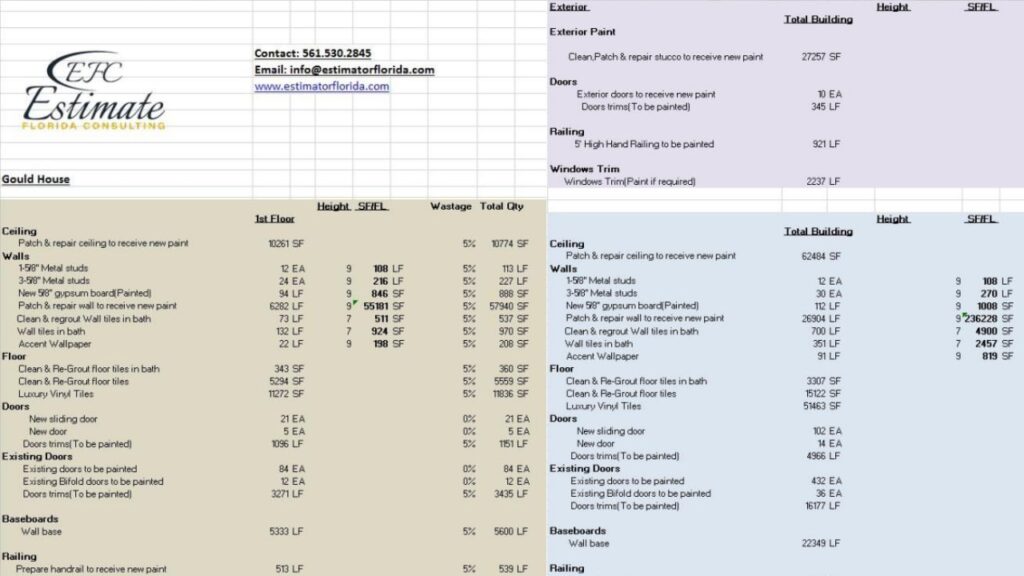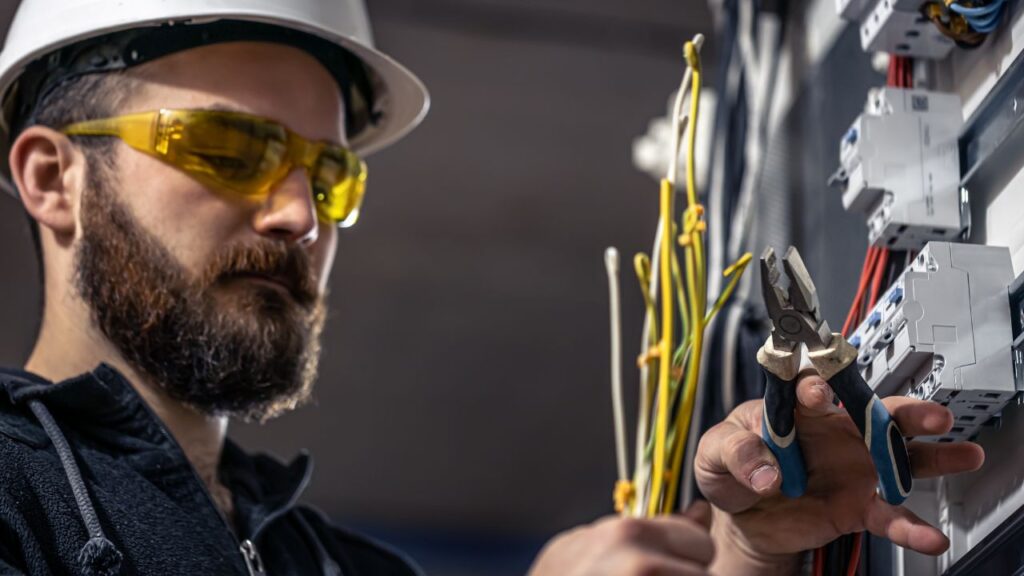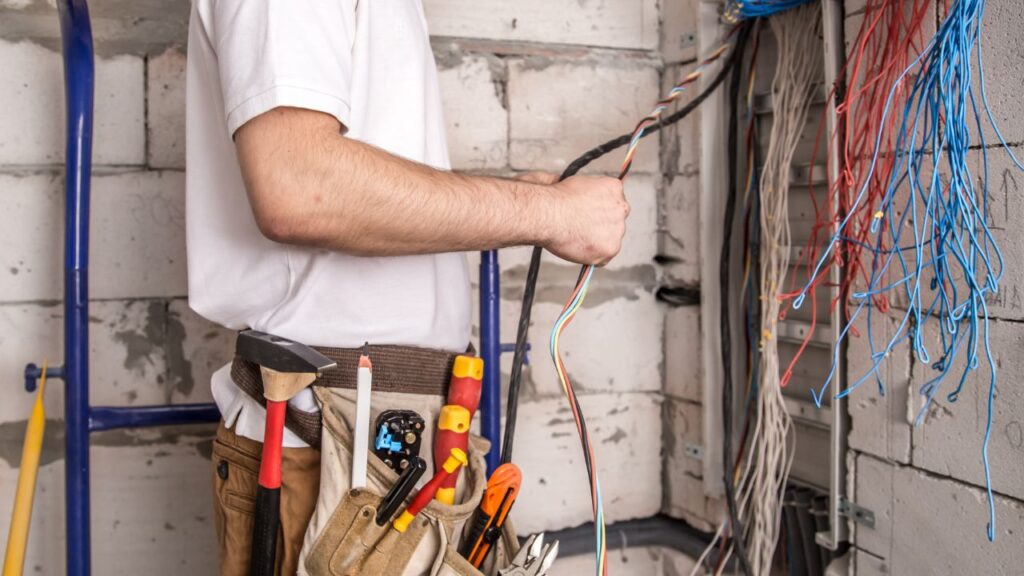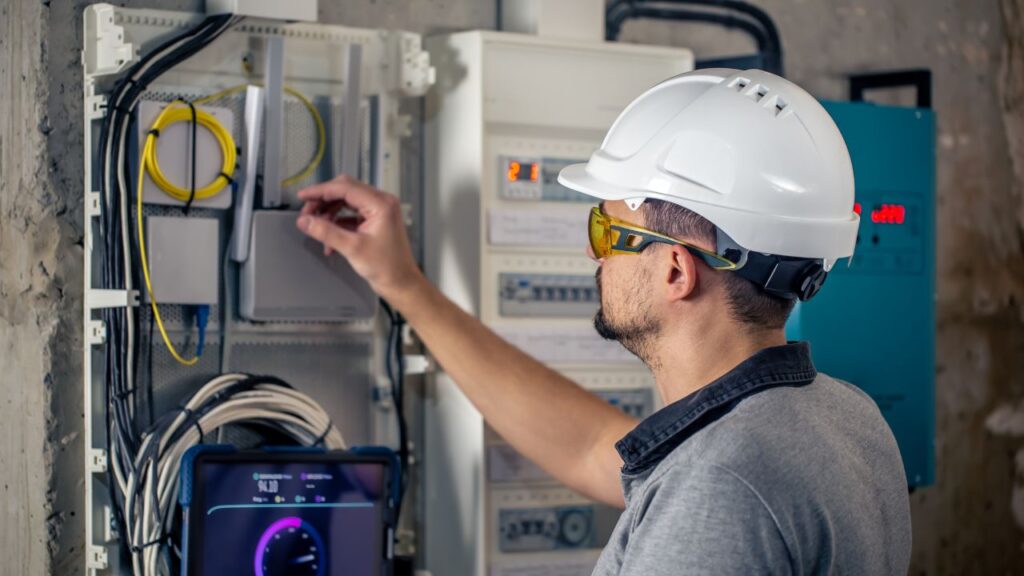A Wining Cost Estimate
That Helps You To Win More Electrical Construction Projects

To understand the scope of the project for installing electrical wiring for home theater systems, you need to tackle three key sub-sections. Begin by determining the size of the home theater system you plan to install. Next, identify the different areas in your house where you will be installing the electrical wiring. Finally, assess the project’s timeline and budget to determine the feasibility of the project.
To size a home theater system, various factors must be considered. These include room size, seating layout, budget, and personal preferences. Detailed planning prevents unnecessary expenses and ensures function.
The table below contains components of a home theater system, their cost range, and recommended options:

Component | Cost Range | Recommended Options |
|---|---|---|
Audio/Visual Receiver | $200 – $1,000+ | Denon AVR-S540BT, Yamaha RX-V685 |
Speakers | $100 – $300+ per speaker | Polk Audio T15, Klipsch Reference R-51M |
Projector or TV | $500 – $3,000+ | LG C9 OLED TV, Epson Home Cinema 5050UB Projector |
Screen or Wall Paint | $50 – $500+ | Elite Screens Sable Frame B2 110”, Behr Silver Screen Paint |
Note: these estimates don’t include installation costs. Personal preferences vary. Ensure all components are compatible and meet specifications.
When sizing a home theater system, physical space isn’t everything. Lighting and sound obstructions also play a role. Acoustic treatments could improve sound quality.
Smart home tech could be added too, for convenience. Voice-controlled devices like Amazon Echo or Google Home can control volume and input selection.
When sizing a home theater system, lots of factors must be taken into account. Plan carefully and examine options to get the most from your cinematic experience.

Determining the exact places to install electrical wiring is an essential part of any electric project. It is very important to identify all aspects to ensure the installation is right and efficient.
A 4-step guide to finding places for wiring:
Furthermore, it is beneficial to look into equipment orientation details based on ergonomic research. This will help with activities related to installation. The more information we have before beginning the project, the more money we can save.
The Construction Review Magazine in May 2021 stated that a company focusing on building components production is ready to go.
Get set to say goodbye to your free time, because analyzing the project timeline and budget is now your new hobby.
To know how far the project will go and how much it’ll cost, you must do a full analysis. Spotting any difficulties and having a plan B is a must. See the following table for an overview:

Phase | Timeline | Budget |
|---|---|---|
Planning | 2 weeks | $20,000 |
Development | 4 months | $200,000 |
Testing | 1 month | $30,000 |
Launching | 2 weeks | $15,000 |
Each stage needs an expected timeline and budget to finish well. But you might need to change it, depending on the situation. Take into account how any changes can affect the project’s timeline and cost. Anticipating these risks can minimize their effect. A warning: We had a customer who wouldn’t give enough time for proper planning and risk assessment. They got delayed and went over budget since they didn’t foresee the problems. It ended up costing them more than if they’d done the assessments at the start.
Don’t be tempted to play ‘guess the wires’ with your home theater system – hire an electrician!
We help contractors find new customers with high-converting websites and locally targeted niche-specific lead-generation programs. You’ll never need to worry about running out of work again! We focus on quality over quantity with our leads for contractors.

To identify the electrical requirements for your home theater system, you need to understand the electrical codes and regulations, list the electrical components needed, and determine the power requirements of the components. In this section, we will explore these sub-sections to help you create a well-informed estimate of the price for installing electrical wiring for your home theater system.
It’s essential to comprehend the electrical regulations that govern codes when installing a home theatre system. Abiding by these is needed to comply with safety guidelines. Even though regulations vary from place to place, you can find updated laws online.
Before setting up a home theatre system, it’s critical to know the national and local rules that relate to electrical fittings. These codes inform which wire and cable types, conductor sizes, and other set up elements are permissible. For instance, NEC 210.12 requires AFCI breakers when a bedroom is involved.
Electrical Engineers or Professionals ensure safety from electrical-related fire hazards by inspecting in-progress installations and testing the equipment for operation and performance.
The National Fire Protection Association (NFPA) reports that in 2020, 52,050 fires began with electrical problems. (Source: https://www.nfpa.org/) Time to get plugged in! Here’s a list of the electrical parts you need for your home theatre system.

To guarantee your home theater system works smoothly, it’s essential to identify the electrical components you’ll need.
Knowing exactly the electrical requirements for each component is a must to avoid damage, failure or performance issues. Choose Energy Star certified devices for efficient energy consumption.
Also, use flexible conduit or cable wrap to reduce untidiness and make cabling manageable. Label wires for easy recognition, and inspect cables and components regularly for optimal functioning.
Let’s hope your home theater system doesn’t need as much power as your ex’s drama!

It’s key to understand the power needs of individual components to determine the electrical requirements of a home theater system. Knowing this info will help you pick the right power sources and outlets. Check out the table below for some common home theater components, their wattage and expected energy consumption. Calculate the total power requirement by adding up all the wattages.
Component | Wattage | Expected Energy Consumption |
|---|---|---|
TV | 150 | 3.6 kWh/day |
Amplifier | 500 | 12 kWh/day |
Subwoofer | 1000 | 24 kWh/day |
Blu-Ray | 25 | 600 Wh/day |
Cable box | 50 | 1.2 kWh/day |
Analyzing the chart reveals how much electricity each component needs. This lets people select the right wall outlets or surge protectors that won’t overload or short out. However, remember that factors like how often and for how long the system is used affect its energy usage.
Before energy-efficient-tv models became popular, flat-panel displays used way more electricity than today’s models. An average non-energy Star-compliant LCD-TV used three times more power than compliant ones of equal size. So, if you want the ultimate movie experience, be prepared to sell a kidney or two to power your home theater system!
To estimate the cost of electrical wiring for your home theater system, you need to consider various factors that affect the overall price. In order to get an accurate estimate, you need to determine the labor cost for installation and list down the materials and equipment needed. This section covers the necessary aspects of estimating the cost, discussing the relevant sub-sections, such as the factors affecting the cost and determining labor cost for installation.

The cost of electrical wiring can differ due to various factors. Some of these are:
Factors | Impacts on Cost |
|---|---|
Size of the space | Bigger area needs more wiring, thus greater cost |
Type of wiring needed | High-grade wires with better insulation and compatibility leads to higher cost |
Installation fees | Professional services add to the overall price |
The complexity of the project | Complex setups require additional labor, equipment, and materials, resulting in higher costs. |
Other elements that might affect wiring prices are location, accessibility, material supply, and upgrades.
It’s important to remember that non-certified technicians or wrong installations may cause future failures or dangers.
As per a HomeAdvisor’s study, which was reported by Forbes, Americans paid an average of $322 for electrical work in 2020.
Installing a home theater system is like doing surgery on your house but with less blood and more wires.

Determining the Expenses of Labor in Installing Home Theater System
The labor cost for installing a home theater system depends on many factors. These include the type and complexity of the system, the number of components needed, and the experience of the installer. Estimating expenses is key to avoiding unexpected costs.
We can create a table with potential expenses based on hourly rates. Include task description, hourly rate, time needed for completion, and total cost. For example, installing a projector can take 4 hours at $60 per hour. Total cost = $240.
Aside from basic wiring and equipment installation, extra expenses may be necessary for customizations or modifications in walls or ceiling. This could affect pre-existing wiring plans.
With custom home theatre systems, installing heavy-duty cables can increase costs significantly. Planning is key to avoid disruptions in daily life.
Research the unique needs of the system and get qualified electricians to review custom wiring adaptations. Short-cuts may lead to unfinished jobs or unsafe homes. So, hire experts with sound professionalism over time.
Listing the Electrical Wiring Materials and Equipment for a Home Theater System
For an effective home theater system, the necessary materials and equipment for electrical wiring are:
The quality of these materials affects the performance of a home theater. Poor quality may lead to signal interference, bad audio/visual, or damage.

Pro Tip: Buy high-quality wiring cables and wall plates for a better experience. DIY may save money, but it could leave you in the dark – literally.
To compare the cost of installing electrical wiring for home theater systems, you have two options: DIY or hiring a professional. In order to make an informed decision, you need to evaluate the risks and complexities of a DIY installation and identify the advantages and disadvantages of hiring a professional. Additionally, analyzing the cost breakdown of DIY vs. hiring a professional can help you determine which option is more cost-effective.
Evaluating the Trouble and Dangers of a Do-It-Yourself (DIY) Project
Doing a DIY project to save money may look inviting, but it’s important to think about the risks and difficulties. Ignoring these factors can cause injury, bad installation, or extra costs.
To understand the prospective troubles with DIY projects, let’s compare two tables. The first one shows the possible risks of a DIY setup, and the second one explains complexities of a professional installation.
Maximize your electrical construction business’s potential with our competitive financing options

Risks
Risk | Description |
|---|---|
Personal injury | No proper tools may cause cuts, sprains, or other injuries |
Material damage | Wrong use may harm materials |
Warranty Voidance | Careless installation may void your product warranty |
Long-Lasting Damage | Bad implementation may make irreparable damages |
Complexity
Complexity | Details |
|---|---|
Technical Skill | Knowing tools and techniques is required |
Safety Regulations | Following regulations is essential |
Time Restrictions | Installation should take place in a precise timeline |
It is critical to keep in mind that the above data is just an overview of potential issues, as each project has its own subtleties.
When attempting a difficult DIY job like plumbing or electrical work, safety must be top priority while performing these complex tasks. Any mistake could lead to serious results.
For example, a homeowner who attempted to install their own plumbing system thought they had done everything correctly until severe water damage happened in the house due to wrong fittings and sealing.
So, it’s best practice not to take on more than you can handle when it comes to intricate setups. If you lack experience or feel unsure about something requiring special skill sets for buying/installing – then getting professional help is the wise option.
Bringing in a pro may cost more, but at least you know who to blame if something goes wrong.
Pros and cons of hiring a pro must be considered. Here’s a cost-perspective breakdown of the advantages and disadvantages:
Advantages | Disadvantages |
Expertise and experience for efficient solutions | Can be expensive |
Quality work with guarantees/warranties | Lack of control over timing/skill quality |
Saves time, reduces stress | Risk of frauds/scams |

Not all tasks require a pro. A thorough cost-benefit analysis should be done based on personal preferences. Research is needed to avoid potential frauds/scams. Seek recommendations from trusted sources. Get quotes from multiple professionals to ensure a fair price range.
Evaluate each option carefully and determine if it’s better to hire a pro or DIY.
Comparing the expense of DIY vs. a professional? Consider the costs carefully! Here’s a close look at the cost comparison:
Task | DIY Cost | Professional Cost | Savings/Losses |
|---|---|---|---|
Painting a Room | $150 (paint, rollers, brushes, etc.) | $450 (labor costs for an average-sized room) | $300 saved by doing it yourself instead of hiring a pro. |
Bathroom Remodeling | $500 – $1,000 (materials and hardware quality) | $4,000 – $15,000 or more (depending on complexity) | Savings could be worth several thousand dollars if you do it yourself. Or losses if mistakes are made. |
Total Savings: $??? (DIY Costs) – $??? (Professional Costs) = $??? (Include every item above or just an example?) | |||
Note:This table shows expected cost considerations. But these are not exact figures. They may vary. | |||
Do your research first! Complicated projects require experienced professionals.
Evaluate the task before deciding to do it yourself or hire outside help. DIY comes with extra costs for materials, tools, and time.
HomeAdvisor says the average cost to hire a pro for home repairs in 2020 was $386-$1,074.
Make an informed decision based on the cost comparisons. When it comes to home theater wiring, it’s a matter of volts versus dollars!

Making a wise decision on the cost of electrical wiring for a home theater system needs careful consideration of many factors. Here’s what you need to know.
Type | Est. Cost/Ft |
|---|---|
Copper Wire | $2 – $4 |
Aluminum Wire | $1.50 – $2 |
Gold Plated Wiring | $10 – $15 |
Apart from the type and cost of wiring, permits, labor charges, equipment rentals are extra expenses that can greatly increase the total project cost.
Planning the electrical wiring for your home theater system requires knowledge of the room size, layout and number of outlets. It’s better to hire a certified electrician who knows local codes and regulations.
To save money, get quotes from two to three electricians before choosing one. DIY installation could also be an option if you have some experience in electrical wiring. However, this may not be suitable for everyone.
Factors that affect the price of installing electrical wiring for home theater systems include the size of the room, the complexity of the wiring required, the type of wiring needed, and the distance from the room to the electrical panel.
To get an accurate estimate, you should consult with a licensed electrician who can assess the specific needs of your home theater system and provide a detailed estimate based on those needs.
Yes, it is highly recommended to hire a licensed electrician to install electrical wiring for your home theater system. Improper installation can be dangerous and can also void any warranties on your equipment.
The average cost of installing electrical wiring for a home theater system can vary widely depending on the specific needs of the system and the location of the home, but generally ranges from $500 to $1,500.
It is strongly recommended that you do not attempt to install electrical wiring for a home theater system yourself unless you are a licensed electrician. Attempting to do so can be extremely dangerous and can also result in damage to your equipment.
The amount of time it takes to install electrical wiring for a home theater system can vary depending on the size and complexity of the system. However, on average, it can take anywhere from 2 to 4 days to complete the installation.
Here I am going to share some steps to get your electrical construction cost estimate report.
You can send us your plan on info@estimatorflorida.com
Before starting your project, we send you a quote for your service. That quote will have detailed information about your project. Here you will get information about the size, difficulty, complexity and bid date when determining pricing.
We do electrical construction cost estimating and prepare a detailed report for your project. At last, you finalize the report and finish the project.
561-530-2845
info@estimatorflorida.com
Address
5245 Wiles Rd Apt 3-102 St. Pete Beach, FL 33073 United States
561-530-2845
info@estimatorflorida.com
Address
5245 Wiles Rd Apt 3-102 St. Pete Beach, FL 33073 United States
All copyright © Reserved | Designed By V Marketing Media | Disclaimer
IMPORTANT: Make sure the email and cell phone number you enter are correct. We will email and text you a link to get started.
By clicking “I Agree” above you give Estimate Florida Consultin express written consent to deliver or cause to be delivered calls and messages to you by email, telephone, pre-recorded message, autodialer, and text. Message and data rates may apply. You are able to opt-out at any time. You can text STOP to cancel future text messages.